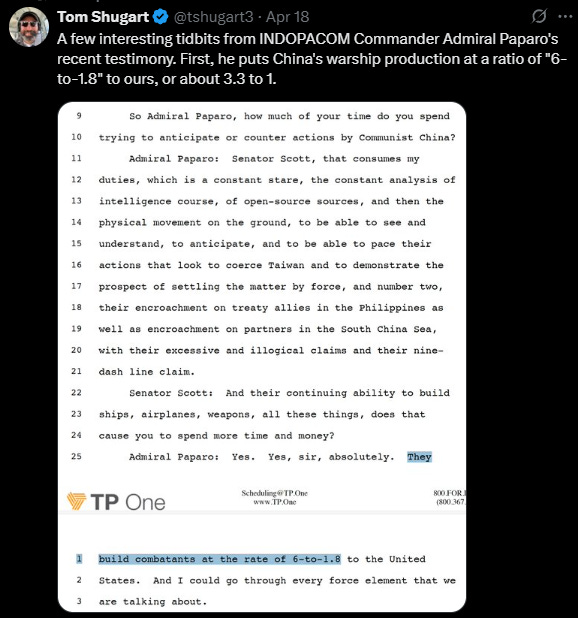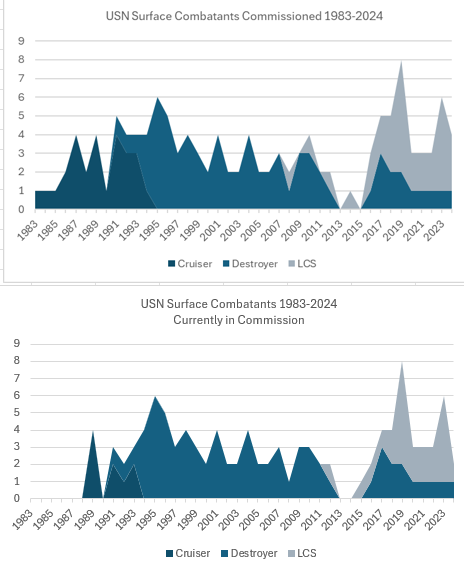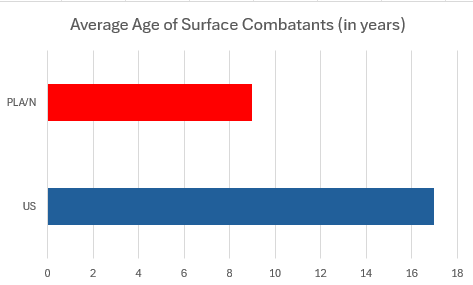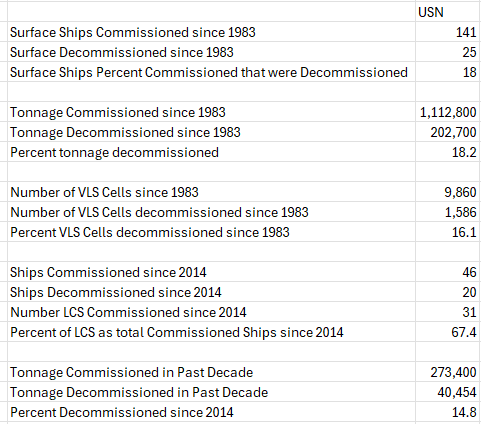For the past several years, at the end of each calendar year, I’ve been posting on TwitterX a thread updating Chinese and US navy shipbuilding numbers. Early on, I received replies like “yeah, but tonnage” (PLAN is outbuilding us) or “yeah, but the US has technological superiority (but PLAN is catching up and how did the Me-262s, UBoat XXIs, V-1s, V-2s, Tigers and Panthers work for Nazi Germany?) It was always a “yeah, but.” That time has ended.
Admiral Paparo recently testified before the Senate. Tom Shugart posted this very important nugget:
3 to 1. That is China’s warship production against the US. How did we get here? Below are my numbers from November. I’m not just reposted them as a reminder of followers from the beginning of this Substack but those many who have joined since I posted this one. I’ll be updating these at the mid-way mark this year and have something that’s more enhanced for everyone. In the meantime, five months ago:
* * * * * * *
For the past three years, I’ve maintained a spreadsheet that’s now being converted and expanded into a database for some private consumption. But the bottom-line graphs I’ve made available because they tell the story of Navy shipbuilding between a power that was and a power that wanted to be. What started that? Although I had studied and written about the Navy for decades either on the Hill, for publications, as a defense contractor, or a federal employee, this was the piece that led to my annual end-of-year review of shipbuilding, titled “Is American Still Born to Rule the Seas?”
Surface combatants are only one aspect of national naval power - there are the aircraft carriers and their accompanying air wings, there is the submarine community (which I also track), cyber warfare, training, intelligence capabilities, etc. But surface combatants have been with us since the ancient Mediterranean powers needed warships to protect their grain shipments and other commerce and, so, that is my primary focus.
Some have suggested that PLA/N ships aren’t as capable as US ships. Possibly. But I counter that the Germans had Me-262s, V-1s, V-2s, advanced subs and advanced tanks - but the Germans could never counter the quantity of inferior platforms by the US and Soviet Union. Also, the Spanish Minister of Marine Segismundo Bermejo made the same assumptions in 1898 - that the Spanish ships were qualitatively superior to the US Navy’s. In two short battles, those assumptions were quickly dispelled.
Some have also criticized the fact that I’ve included PLA/N corvettes. This also goes to the argument of “range.” I included the ships for three reasons: 1) PLA/N corvettes, although far less in tonnage, are roughly as capable as Littoral Combat Ships in the USN; 2) the most likely place for a naval conflict will be in the South China Sea or Taiwan Strait region so China won’t need the range USN vessels will; 3) LCSs would unlikely be deployed en masse to the region especially because of their lack of range.
Readers will understand the graphs, but I’ll provide a one- or two-line summary.
A population pyramid. BLUF: USN has an aging fleet while PLA/N is the young gun.
USN Shipbuilding shifted from cruisers to destroyers to Littoral Combat Ships. The last is a killer since no Arleigh Burke or Zumwalt since 1991 has decommissioned and yet several of the newer, far less capable LCSs have decommissioned within just a few years.
A comparison of USN and PLA/N shipbuilding by class and following that by total number. The past decade is telling and why PLA/N became the largest Navy
Average age of surface combatants is important because older ships - like people - have a lot more wear and tear and need more maintenance. Maintenance costs time and money. With a larger fleet, the PLA/N’s deployments to HOA give them the expertise of blue water operations without the cost.
This graph shows the incredible shipbuilding capacity of China, now estimated to be 262x the amount of the US.
Critics of raw ship numbers were correct that that was only one way to view this comparison; they assumed USN tonnage was greater. That is only true for the past forty years but in the past ten years, China has surpassed USN in tonnage, largely because the US focused on building primarily Littoral Combat Ships.
A similar critique has been the advantage of Vertical Launch System (VLS) cells on surface combatants, but again that assumption is incorrect with construction in the past decade. This is important because more USN cruisers will be decommissioned in the next two years as well as the start of decommissioning Flight I Arleigh Burkes.
Some of the raw numbers for these and unreleased graphs:
Comparison in tonnage over time
And, finally, a comparison of the raw numbers between USN and PLA/N:
Unless there are drastic changes, the US Navy will not regain its status as the largest navy in the world and China will be unrivaled for most of the century. There are several reasons for this including:
a shipbuilding industrial base without the capacity to significantly expand in the short or long term
the length of time required to build a ship (5+ years from authorization to commissioning for DDGs)
national budget priorities for the US are more geared to domestic programs rather than national security
the failure of the LCS program, the failure to design and build a follow-on cruiser program to the Ticonderogas, the failure to design and build a follow-on destroyer to the Burkes, the government’s decision not to build 32 Zumwalt-class destroyers but only three, etc
















> 1) PLA/N corvettes, although far less in tonnage, are roughly as capable as Littoral Combat Ships in the USN;
I honestly can't tell if you're damning the PLA/N Corvettes with this statement.